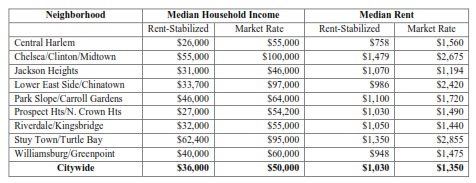
On June 15th, rent regulations that protect nearly three million New York City tenants will expire.
Democratic officials overwhelmingly support strengthening the rent laws, since their constituents rely on them. Upstate Republicans oppose a strong renewal, ideologically yes, but also because -- as the head of the landlords' lobby said in a revealing recent video -- landlords have "emptied our piggy bank" for Republican Senate Leader Dean Skelos.
But let's get beyond the politics. Most economists are critical of rent regulations. Plenty of liberals feel uncomfortable about them, too. They wonder whether it is fair to have landlords provide a subsidy. They question why non-poor New Yorkers receive the benefit. They hear about tenants who cheat the system. They seem embarrassed that NYC has an old−fashioned price control that dates from World War II.
Here's why that thinking is wrong: rent regulations are essential to a diverse New York City.
First, to debunk a few myths. Rent regulations don't dampen new construction -- developers can build new housing, and the regulations don't apply. While there are certainly plenty of middle-class families who benefit, the average income of families in rent−regulated apartments is $36,000, and 60% are people of color. We could never afford a housing subsidy program of this magnitude -- to pay the difference between rent-stabilized and non-stabilized rents, for the lower-income half of households, would cost $1.6 billion every year.
Rent regulations aren't just our best affordable housing program. They are something much deeper: policy for a diverse, stable city.
The economists have a case. It would certainly be more economically efficient for the Sanchez family in Bushwick to move to East New York; for the remaining working-class Italians, Puerto Ricans, and African-Americans to be driven out of Park Slope; and the last teachers out of Stuy-Town. Rents and property values would rise, so we would likely collect a little more in property taxes.
But wouldn't we lose something much bigger? Something like our city's soul? New York City is not Detroit, thank goodness. We continue to attract new residents -- immigrants from India, and musicians from Missouri. But we aren't San Francisco either, where fewer than 15% of the population is black or Hispanic, and the median income is $72,000 (NYC's is $50,000).
Why? Largely because of rent regulations. Rent regulations mean that if you are a tenant, and you pay your rent, you won't have to leave your neighborhood when the yuppies or hipsters or artists or investment-bankers or sports arenas come. Your rent will go up a bit every year, so landlords can cover their costs. But if real estate values double in your neighborhood -- through nothing you or your landlord did -- you won't have to leave just as the neighborhood gets a bit safer, and your kids' public school starts improving.
New data on NYC neighborhoods, provided by the Furman Center at NYU makes the case: in gentrifying Prospect Heights, Brooklyn, for example, median unregulated rents are up to $1,500, and the household income in those units is $54,200. In regulated units there, median rent is $1,030, and household income is $27,000. The story is comparable in neighborhoods across the city:

Is there cheating? Of course there is. Some tenants sublet units they aren't living in, sometimes even more than one (just like some landlords lie about improvements to boost rents).
But rent regulations have stood the test of time remarkably well. After WWII, housing demand massively outpaced supply, and rent regulations were put in place to provide some balance. We tried deregulation in 1971. Price-gouging and harassment ensued, so regulations were re-implemented in 1974.
Today, we have by far the most robust market for multi-family housing in the country. The regulations provide predictability that helped us weather the housing crisis better than most places. Building conditions in the most recent triennial survey were the best ever recorded.
Unfortunately, when the regulations were last renewed under Governor Pataki, a series of loopholes were put in place. The result? Hundreds of thousands of low-rent units in neighborhoods throughout the city have disappeared forever.
I understand why landlords want to keep those loopholes in place. And I understand why investment bankers in Greenwich, or free-market economists in Princeton, might not place that much value on diverse, stable, urban neighborhoods. I assume they don't prefer Detroit. But maybe they would prefer San Francisco.
But if you've got E.B White's "Here is New York" or the WPA Guide to NYC on your bookshelf, or you like shopping on neighborhood retail strips, or you treasure the diversity of our neighborhood parks, our subway trains, and our public schools -- places where diversity becomes opportunity -- then I'm guessing you prefer New York City.
If so, you should prefer stronger rent laws, too.
Brad Lander is a New York City Councilmember from Brooklyn.